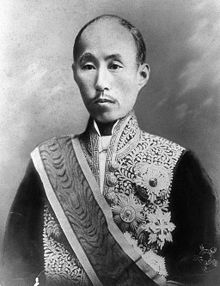Sanjō Sanetomi
| Sanjō Sanetomi | |
|---|---|
| 三条 実美 | |
 |
|
|
Prime Minister of Japan Acting |
|
|
In office 25 October 1889 – 24 December 1889 |
|
| Monarch | Meiji |
| Preceded by | Kuroda Kiyotaka |
| Succeeded by | Yamagata Aritomo |
| Chancellor of the Realm of Japan | |
|
In office 13 September 1871 – 22 December 1885 |
|
| Monarch | Meiji |
| Preceded by | Tokugawa Ienari |
| Succeeded by | Position abolished |
| Personal details | |
| Born |
13 March 1837 Kyoto, Tokugawa (now Japan) |
| Died | 18 February 1891 (aged 53) Tokyo, Japan |
| Political party | Independent |
Prince Sanjō Sanetomi (三条 実美?, 13 March 1837 – 18 February 1891) was an Imperial court noble and statesman at the time of the Meiji Restoration. He held many high-ranking offices in the Meiji government.
Born in Kyoto, Sanjō was the son of Naidaijin Sanjō Sanetsumu. He held several important posts in Court and became a central figure in the anti-Western, anti-Tokugawa sonnō jōi ("Revere the Emperor, Expel the Barbarian") movement.
When the coup d’etat of September 30, 1863 brought the more moderate Aizu and Satsuma factions into power, he fled to Chōshū. He returned to Kyoto after the resignation of Shogun Tokugawa Yoshinobu in 1867.
The first administrative offices (Sanshoku) of the Meiji government were established on January 3, 1868: the Sōsai (President), Gijō (Administration) and San'yo (Office of Councilors). These offices were abolished on June 11, 1868, with the establishment of the Daijō-kan (Grand Council of State). In the new Meiji government, Sanjō was head of the Gijo, Minister of the Right (右大臣) (June 11, 1868 – August 15, 1871), and Chancellor of the Realm (Daijō-daijin) (August 15, 1871 – December 22, 1885).
Sanjō was awarded Grand Cordon of the Supreme Order of the Chrysanthemum in 1882. On July 7, 1884, his title was changed to that of koshaku (prince) under the kazoku peerage system.
...
Wikipedia
